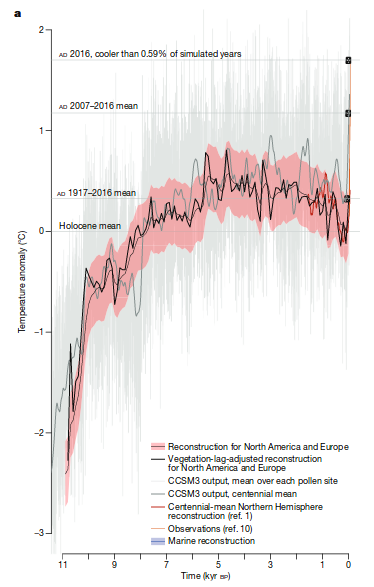How Big a Disaster Can Climate Change Be?
Above, you can see an image from the paper by Marsicek et al., just appeared on Nature. It shows a reconstruction from pollen records of the temperatures of the past 10,000 year or so, the “Holocene,” for North America and Europe. Note the black squares, showing how fast temperatures have been growing during the past 50 years or so.
As all reconstructions of the past, this one has to be taken with some caution, but it fits well with the various “hockey sticks” that research continues to produce despite the attempts to discredit both the science and the scientists who work in this field. So, we can assume these results to be reasonably reliable. Then, we can note a few interesting things.
1. What we call “civilization” arose and continued to exist during a period of relatively constant temperatures, that is, during the past 5000 years or so. During this period, the oscillations in the graph are never more than about half a degree. That’s probably not a coincidence. Agriculture and civilization come together and it is unlikely that agriculture could have been developed for wildly oscillating temperatures and rapidly varying climates
2. Civilizations seem to grow and collapse because of internal factors – the fall of empires doesn’t seem to be correlated to climate change. For instance, you can look in the graph for the data corresponding to the fall of the Roman Empire, between 2000 and 1500 years ago. Temperatures are flat, at most cooling a little. It is a point that I already made on the basis of another set of data specific for the region occupied by the Roman Empire. These more detailed data show a cooling period in Europe, but after the fall of the Empire.
…click on the above link to read the rest of the article…
